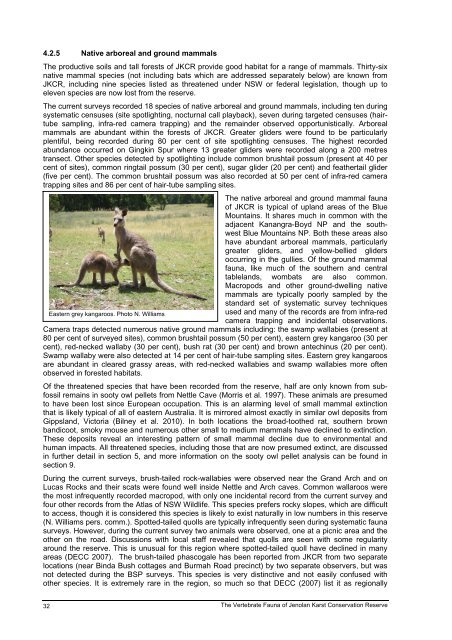The Vertebrate Fauna of Jenolan Karst Conservation Reserve: Final
The Vertebrate Fauna of Jenolan Karst Conservation Reserve: Final
The Vertebrate Fauna of Jenolan Karst Conservation Reserve: Final
Create successful ePaper yourself
Turn your PDF publications into a flip-book with our unique Google optimized e-Paper software.
4.2.5 Native arboreal and ground mammals<br />
<strong>The</strong> productive soils and tall forests <strong>of</strong> JKCR provide good habitat for a range <strong>of</strong> mammals. Thirty-six<br />
native mammal species (not including bats which are addressed separately below) are known from<br />
JKCR, including nine species listed as threatened under NSW or federal legislation, though up to<br />
eleven species are now lost from the reserve.<br />
<strong>The</strong> current surveys recorded 18 species <strong>of</strong> native arboreal and ground mammals, including ten during<br />
systematic censuses (site spotlighting, nocturnal call playback), seven during targeted censuses (hairtube<br />
sampling, infra-red camera trapping) and the remainder observed opportunistically. Arboreal<br />
mammals are abundant within the forests <strong>of</strong> JKCR. Greater gliders were found to be particularly<br />
plentiful, being recorded during 80 per cent <strong>of</strong> site spotlighting censuses. <strong>The</strong> highest recorded<br />
abundance occurred on Gingkin Spur where 13 greater gliders were recorded along a 200 metres<br />
transect. Other species detected by spotlighting include common brushtail possum (present at 40 per<br />
cent <strong>of</strong> sites), common ringtail possum (30 per cent), sugar glider (20 per cent) and feathertail glider<br />
(five per cent). <strong>The</strong> common brushtail possum was also recorded at 50 per cent <strong>of</strong> infra-red camera<br />
trapping sites and 86 per cent <strong>of</strong> hair-tube sampling sites.<br />
<strong>The</strong> native arboreal and ground mammal fauna<br />
<strong>of</strong> JKCR is typical <strong>of</strong> upland areas <strong>of</strong> the Blue<br />
Mountains. It shares much in common with the<br />
adjacent Kanangra-Boyd NP and the southwest<br />
Blue Mountains NP. Both these areas also<br />
have abundant arboreal mammals, particularly<br />
greater gliders, and yellow-bellied gliders<br />
occurring in the gullies. Of the ground mammal<br />
fauna, like much <strong>of</strong> the southern and central<br />
tablelands, wombats are also common.<br />
Macropods and other ground-dwelling native<br />
mammals are typically poorly sampled by the<br />
standard set <strong>of</strong> systematic survey techniques<br />
Eastern grey kangaroos. Photo N. Williams<br />
used and many <strong>of</strong> the records are from infra-red<br />
camera trapping and incidental observations.<br />
Camera traps detected numerous native ground mammals including: the swamp wallabies (present at<br />
80 per cent <strong>of</strong> surveyed sites), common brushtail possum (50 per cent), eastern grey kangaroo (30 per<br />
cent), red-necked wallaby (30 per cent), bush rat (30 per cent) and brown antechinus (20 per cent).<br />
Swamp wallaby were also detected at 14 per cent <strong>of</strong> hair-tube sampling sites. Eastern grey kangaroos<br />
are abundant in cleared grassy areas, with red-necked wallabies and swamp wallabies more <strong>of</strong>ten<br />
observed in forested habitats.<br />
Of the threatened species that have been recorded from the reserve, half are only known from subfossil<br />
remains in sooty owl pellets from Nettle Cave (Morris et al. 1997). <strong>The</strong>se animals are presumed<br />
to have been lost since European occupation. This is an alarming level <strong>of</strong> small mammal extinction<br />
that is likely typical <strong>of</strong> all <strong>of</strong> eastern Australia. It is mirrored almost exactly in similar owl deposits from<br />
Gippsland, Victoria (Bilney et al. 2010). In both locations the broad-toothed rat, southern brown<br />
bandicoot, smoky mouse and numerous other small to medium mammals have declined to extinction.<br />
<strong>The</strong>se deposits reveal an interesting pattern <strong>of</strong> small mammal decline due to environmental and<br />
human impacts. All threatened species, including those that are now presumed extinct, are discussed<br />
in further detail in section 5, and more information on the sooty owl pellet analysis can be found in<br />
section 9.<br />
During the current surveys, brush-tailed rock-wallabies were observed near the Grand Arch and on<br />
Lucas Rocks and their scats were found well inside Nettle and Arch caves. Common wallaroos were<br />
the most infrequently recorded macropod, with only one incidental record from the current survey and<br />
four other records from the Atlas <strong>of</strong> NSW Wildlife. This species prefers rocky slopes, which are difficult<br />
to access, though it is considered this species is likely to exist naturally in low numbers in this reserve<br />
(N. Williams pers. comm.). Spotted-tailed quolls are typically infrequently seen during systematic fauna<br />
surveys. However, during the current survey two animals were observed, one at a picnic area and the<br />
other on the road. Discussions with local staff revealed that quolls are seen with some regularity<br />
around the reserve. This is unusual for this region where spotted-tailed quoll have declined in many<br />
areas (DECC 2007). <strong>The</strong> brush-tailed phascogale has been reported from JKCR from two separate<br />
locations (near Binda Bush cottages and Burmah Road precinct) by two separate observers, but was<br />
not detected during the BSP surveys. This species is very distinctive and not easily confused with<br />
other species. It is extremely rare in the region, so much so that DECC (2007) list it as regionally<br />
32<br />
<strong>The</strong> <strong>Vertebrate</strong> <strong>Fauna</strong> <strong>of</strong> <strong>Jenolan</strong> <strong>Karst</strong> <strong>Conservation</strong> <strong>Reserve</strong>

















